The Aegean area (Greece, the islands in the Aegean, and the region of Turkey along the Aegean coast, known as Ionia) was a backwater around 2000 BC because it didn’t have the right soil or climate for mass irrigated agriculture as Egypt and Mesopotamia had. Here’s a shot from Google Maps showing a typical bit of the Aegean island of Chios; it’s about two miles across:
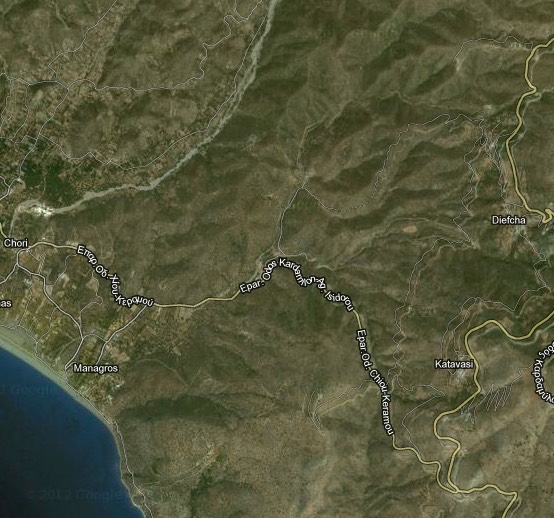
You can readily see how mountainous and arid the land is. In the upper left you can just detect some agriculture. Here’s a closeup of a portion of the upper left corner:
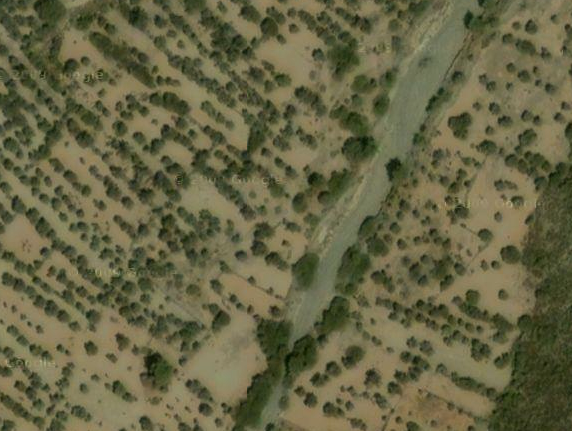
Those are olive trees; you can see that they are not exactly flourishing. The dried creek bed running through the center of the image gives you a pretty good impression of just how arid this area is. It’s pretty much like this all over the Aegean and in much of Greece. There just isn’t much good land for growing cereals; this land was only good for growing olives and grapes, and you can’t live on a diet of olives and grapes. Thus, the entire Aegean was thinly populated. And of course, when the Sea Peoples swept through, they killed most of those few wretches.
The recovery from the Dark Ages
We know that the recovery from the depredations of the Sea Peoples began around 900 BCE. Population all over the Aegean littoral began a dramatic rise. Indeed, the increase in population was nothing short of explosive – in Attica, the population growth was between 300% and 800% over the course of a single century. These are sensational figures; I cannot recall any period in history rivaling such explosive growth.
A phenomenon this extraordinary demands an extraordinary explanation; what could have caused this population explosion? The answer must involve an equally large increase in the food supply, because food supply has always been the primary long-term limiting factor for populations. What could have increased the food supply so dramatically?
One argument is that the population explosion was nothing more than a recovery from the depopulated times of the Dark Ages. This hypothesis assumes that the social chaos of the Dark Ages crippled agricultural output; the re-establishment of social stability was the only thing needed to restore the population to its original levels. The problem with this explanation is that the Greek population did not merely recover to its earlier levels; it shot past those levels and continued growing at unheard-of rates. No, this was not a mere case of “bounce-back” – there was something entirely different at work here.
An alternate explanation hypothesizes some kind of improvement in agricultural practice: perhaps adoption of a new and better crop, improved soil management techniques, a better plow, or irrigation. This hypothesis runs afoul of the archaeological record; there is no evidence of any such change taking place in Greek lands. We know that the Greeks were using the same cereals (primarily wheat and barley) that were being used in similar climes. The “improved agricultural methods” hypothesis just doesn’t pan out.
Olive Oil and Wine for Grain
My explanation for the population explosion in Greece requires some background to explain. The Minoans had created the first large-scale trading system in the Eastern Mediterranean, but it was held back by low cargo capacities and long voyage times. But in the 600 years following the Minoan collapse, a series of small developments converged to change everything.
The Aegean area has highly variable rainfall. From year to year, rainfall may vary by 50%. This means that crop yields are completely unpredictable. Moreover, this variability is highly localized. Robin Osborne, in Greece in the Making 1200 - 479 BC, points out that Greek topography is so rugged that regions just 20 miles apart can go through completely different cycles of drought and rainfall. During the Bronze Age, this variability did not matter much because populations were low enough to survive most droughts. But I believe that the development of bigger ships and greater reliance on sail power opened up a completely new economic system, at first born of necessity but later triggering a population explosion. Trading in grain is not economically viable overland, especially over Greece’s rough terrain. But trading grain by sea is another matter entirely. I believe that the early Greeks developed a system for overcoming the vagaries of drought by trading surpluses among themselves. At first, this was nothing more than an immediate response to a local crisis, but it evolved into something completely different.
Consider the problem of the community facing a grain shortage. Obviously, they want to purchase grain from a nearby community, but what have they to barter with? The answer, it turned out, was wine and olive oil. Grapes and olive trees are not as susceptible to drought as cereals are. If your community maintains a sufficient number of olive trees and grapevines, then in bad crop years it can fall back on the olive oil and wine to trade for imported grain.
Crucial to this process was the fact that olive trees and grape vines flourish in soils and climates that are marginal for cereals. The shallow roots of cereals require frequent rains or irrigation to get them through the growing season, but grapevines and olive trees send their roots much deeper into the soil, allowing them to thrive in hotter, drier climates, and soils too poor to support cereals. The Aegean littoral has few river valleys appropriate for cereal agriculture; these valleys had provided the food supply during the Bronze Age. That food supply was too small to support a large population.
“Why didn’t they simply consume their own olive oil and wine?” you might ask. Why go to the trouble of trading the stuff for wheat when you could just rely on olive oil and wine for sustenance? The problem here is that the caloric value of wine and olive oil is insufficient to sustain a population. That is, if you grow and consume olive oil and wine, you’ll starve, because the caloric returns are less than your caloric investment. The value of olive oil and wine is gustatory, not caloric.
Another important factor was seafood. The new Greek civilization had its population centers right on the coast, not in the interior, as was the case with many of the older Mycenaean towns that were sited in the small river-watered valleys in the interior. The coast gave access to seafood, which could provide an adequate diet. The problem with seafood is that it doesn’t keep for more than a few days, which means that you have to go out fishing nearly ever day. What if there’s a long period of stormy weather? Then you risk drowning if you go out fishing and starving if you don’t.
Rich people will trade a lot of wheat calories for a smaller amount of olive oil and wine calories. This is a common driving force for trade; recall that the European voyages of discovery were driven by the huge economic returns of spices from south Asia. Throughout history, people have survived on dreadfully dull diets: porridge, gruel, and bread were the mainstay of most diets right up into modern times. Any source of variety was highly valued. Of course, the pleasures of alcohol did not go unnoticed.
At first trade was nothing more than an expedient, an ad hoc solution to an immediate crisis. But once the basic concept had taken hold, it began to expand in every direction. People planted more and more olive trees and grapevines to provide better safeguards against drought. The range of trade was extended; people further and further away began participating in the trading system. What drove this process into a virtuous circle was the fact that the Greeks could get more food by growing grapes and olives than by growing grain. For a given amount of land and labor, they could obtain more grain by growing olives and grapes and trading the olive oil and wine for grain. This created an incentive to plant more and more olives and grapes. The balance point between grain and cash crop lay in the additional cost of transportation and the richness of the soil. It still made sense to grow grain in the flat, well-watered lowlands with rich soil. As the Greek population grew and sold more olive oil and wine, they created food surpluses that caused their population to expand. This in turn created incentives to improve the trading system: ships, navigational techniques, connections with foreign ports, and so forth. Once this virtuous circle began turning, it just kept turning faster and faster.
This stimulated the development of larger ships. The Minoan ships were typically 10 or 20 tons in displacement, but by 1200 BCE, there were 50-ton ships plying the Mediterranean. And bigger ships with more cargo capacity stimulate even more trade. We know that some of these ships carried grain; a letter from Ugarit to the Egyptian Pharoah expressed appreciation for the recent shipment of grain to the city. The archaeological record suggests that most trade was confined to expensive items: spices, jewels, metals, and cedar wood. While this is surely true of trade by land, seagoing trade is nowhere near as limited in capacity. A 50-ton ship laden with spices, jewels, metals, and cedar would have presented an irresistible target for pirates. Capturing a single such ship would have made the members of a pirate crew wealthy for life. Under such circumstances, larger ships would have been liabilities; shipping would have continued to rely on small vessels. But it didn’t; the maritime history of the Mediterranean shows a steady increase in the size of ships. That’s because they were carrying more and more lower-value cargoes: wine, olive oil, and grain.
The second development was the gradual replacement of oar power by sail power. This process was very slow; Europeans were still using oar-powered war galleys in 1500 CE. There’s no question that the Minoan craft used sails as opportunity arose; but they relied on oars as their primary power source. In the Odyssey, Homer describes Odysseus’ men dragging their ship onto the beach -- you can’t do that with a ship with a deep keel. But driving a 50-ton ship with oar power is a lot harder than driving a 10-ton ship with oar power. Why? The answer is complicated; basically, things don’t scale up neatly. You can build a paper airplane that will fly quite nicely, but if you try to make a paper airplane that’s ten times bigger and uses cardboard instead of paper, it won’t fly anywhere near as well as the paper airplane. A deer the size of an elephant would collapse under its own weight. In the same way, scaling up a ship from 10 tons to 50 tons doesn’t work by simply quintupling the number of oarsmen. Those oarsmen need space to work in, which makes the ship longer, which makes it even heavier, which requires even more oarsmen... this just doesn’t add up.
You might object that the Greek trireme of 500 BCE was exactly what I’m saying is impossible: a big, powerful ship with loads of oarsmen. But a trireme was a warship, not a merchantman; it had zero cargo capacity. Its only purpose in life was to ram other triremes. For that it needed the ability to move quickly for short periods of time. The difference between the Greek trireme and the merchantman was similar to the difference between a dragster and a Mack truck. Since triremes did not rely on sail power they didn’t need keels. The basic quandary still faced the merchantman: adding more cargo capacity demanded more oarsmen, reducing cargo capacity.
The solution was to rely more and more on sail power. The transition relied on a number of developments. Shipbuilders had to learn how to optimize the ratio of the beam (width) to the length of the ship; how to attach taller and taller masts that wouldn’t tear loose from the ship in a gale; how to improve construction techniques to achieve more streamlined hulls, and many other things. Early sailors had to learn the ways of the winds, building up a store of knowledge of when, where, and in what direction winds tended to blow. By deepening the keel, shipbuilders were able to increase the fraction of time that sail power could replace oar power. These early sailors had to learn a great deal about how to handle a ship using sail power. There was rigging to consider, and how to handle a ship with a deeper keel, and navigation, and above all, the art of tacking: sailing into the wind.
Frogs around the pond
Here’s a map of Greece and the Aegean:
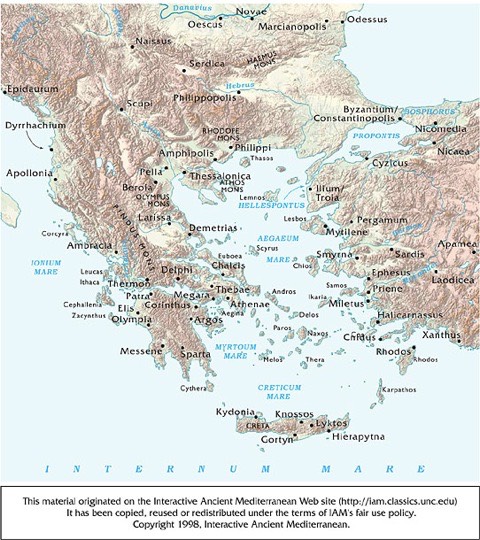
Now, we modern people think of Greece this way:
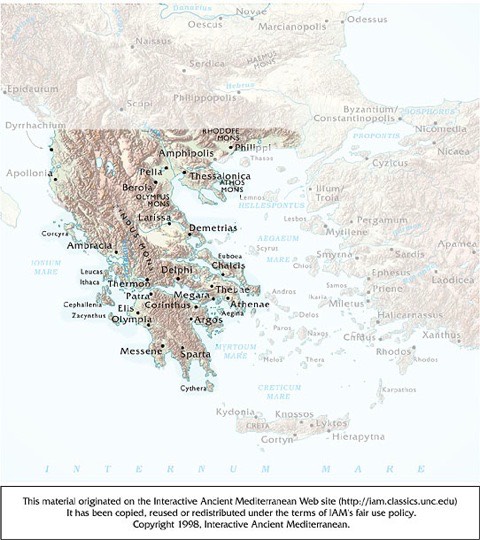
But the original Greece looked more like this:
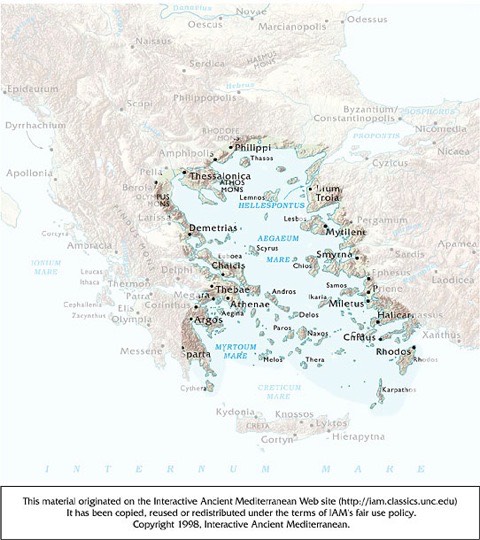
Plato referred to the Greeks as “frogs around a pond”, referring to the Aegean, and there’s plenty of evidence to support this notion. For example, in Robin Osborne’s aforementioned book, he presents two maps of sites occupied during two different periods: 1125-1050BC, and 1050-1000BC. Each place where some indication of occupation has been discovered is marked by a dot on the map. I went through both maps, measuring the distance of each site from the seacoast, and compiling a table of how many sites were found at increasing distances from the seacoast. Here are my results:
| Distance | 1125-1050BC | 1050-1000BC |
| 0-10km | 39 | 37 |
| 10-20km | 22 | 7 |
| 20-30 km | 6 | 6 |
| 30-40 km | 4 | 0 |
| 40-50 km | 7 | 0 |
| >50 km | 10 | 0 |
And here is a histogram showing the same data:
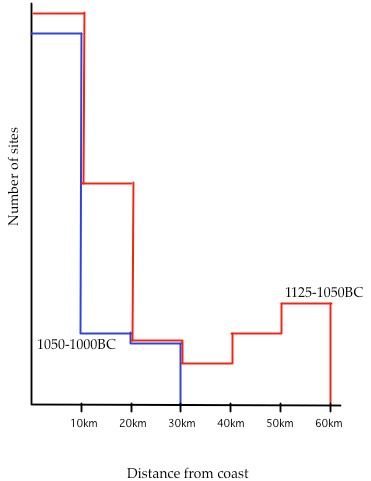
This shows that the population appears to have shifted closer to the sea with the passage of time; I think it is because trade by sea was beginning to play a larger role in the local economy.
This population increase and its foundation had profound ramifications for the political organization of societies. In conventional river-valley civilizations, such as China, Mesopotamia, and Egypt, a bully with some goons could dominate the farmers in any neighborhood. He’d establish a central base, providing a protection racket for his farmers, chasing off raiders and in return commandeering the surplus agricultural output, which he then used to trade for luxury goods. The political evolution of these societies was a straightforward manner of growth by consolidation, with local despots engaging in hostile takeovers of their neighbors, amassing ever-larger kingdoms.
That was system used in Mycenaen Greece during the Bronze Age. But the Mycenaen civilization collapsed during the Bronze Age Collapse, and for a long time there was no significant government in Greece; instead, small groups huddled together in mutual protection. When the population explosion began, the bullies with their goons appeared out of the woodwork and tried to establish the conventional despotisms. But this time it didn’t work, because a society of merchants can’t be controlled by the same protection rackets that a society of farmers is vulnerable to. Sure, the local bully can establish hegemony over the farmers, but he can’t touch the merchants – they’ll just sail away! The merchants are crucial to the survival of the town. If the bully gets on bad terms with the merchants, they’ll do business with more congenial towns. The bully’s people won’t enjoy the rapid population growth, and will eventually be inundated by the hordes of Greeks from the merchant-friendly towns.
This would take us to the next stage in political organization. Greece would be organized as a collection of city-ports, each controlled by its local despot, who takes all the wine and olive oil manufactured by the downtrodden farmers. He uses some of it for himself, and the rest he sells to merchants for grain. He distributes the grain to the peasants, winning their loyalty. The merchants live in a special quarter at the port and are accorded complete freedom of action. The system works, and everybody wins (except the peasants, of course, who always lose).
But this system has a weakness. The excess population generated by that extra grain has to go somewhere. The land is quickly filled with farmers, and all those new mouths have to make a living somehow. There are two ways to do this: divert more of the population to manufacturing pursuits, and export population. That’s what the Greek towns – now cities – began doing. Greek civilization was able to divert a higher percentage of its population to manufacturing pursuits than other civilizations.
Digression: agricultural surplus and economies of scale
The agricultural surplus of any society is simply the percentage of the population that does not need to farm to feed itself -- it can live on the surplus created by the farmers. Throughout most of ancient history, the agricultural surplus was very small, perhaps only a few percent. A society with an agricultural surplus of 1% could support one non-farmer with every hundred farmers. That non-farmer might be a soldier, scribe, administrator, or royalty. He might also be involved in manufacturing, such as building ships, houses, or pots. Obviously, societies with low agricultural surpluses had small numbers of people making manufactures, with concomitant low supplies of such manufactures.
Most manufacturing enjoys economies of scale: the bigger your manufacturing operation, the more stuff you can make per unit cost. Moreover, large manufacturing operations can afford more R&D, discovering (if only by serendipity) new and improved techniques. Thus, as your agricultural surplus grows, you can devote more labor to manufacturing, which in turn becomes more efficient, increasing your overall production even more.
This is what happened in Greece. By trading wine and olive oil for cereals, the Greeks amassed a gigantic agricultural surplus, which in turn permitted the establishment of large manufacturing operations, which were more productive than competing manufacturing operations elsewhere. This gave the Greeks yet another basis for economic growth: trading manufactures for even more grain.
At first, this was all wonderful for the bully boys running the Greek cities. But their rule was steadily being undermined by economic forces. A protection racket only works on people who are tied to their land: farmers. Mobile labor, such as merchants and artisans, can easily pull up stakes and move to a more congenial place. Therein lay the seeds of Greek democracy. Despotism couldn’t compete with democracy in attracting and retaining the best artisans, the most productive laborers, and most effective merchants. All the talent emigrated to democratic cities, leaving the despots lording it over the backwater cities, which eventually got the message and threw out their despots.
There was still social stratification, but the key is that the social stratification was not based so much on land ownership as on mercantile success. In other words, the leading citizens weren’t just the landed aristocracy, they also included the merchants. There was lots of overlap between the two groups, but their relationship was dynamic and worked, in general, to the advantage of the merchants. The landed aristocracy could not guarantee the food security of the community; only the merchants could do that. While the landed aristocracy was a closed social group maintaining its dominance through inheritance, the merchants were a meritocracy open to anybody. Thus, the fossilization inherent to aristocratic systems was kept at bay by the constant injection of new blood from the merchant class.
Community spirit
The Achaeans had one more hurdle to jump before they could become Greeks: piracy. Remember, it takes only one bad apple to ruin everything for the peace-loving folk. In Minoan times, the Minoan navy kept piracy down. But in the ninth century BCE there was no central king to enforce the king’s peace; the Aegean was still a collection of small towns with no common government.
Piracy disrupted the trade networks that provided the grain that kept the population alive; as such, piracy was a direct threat to the survival of the Aegean community. For land-based communities self-sufficient in food, piracy was a nuisance that deprived rich people of their luxury goods. But for the Achaeans, piracy meant starvation. Since they could not stop it as individual polities, they had no choice but to develop a group response. They had to establish a group identity and an overall sense of group justice, and -- supremely important -- they had to make this system work voluntarily. There was no single Greek city powerful enough to sweep clean the seas by itself. They had to work together or starve. Hence, people had to agree on some basic principles of behavior in order to keep the trade system operational. Just as music soothes the raging beast, trade civilized the Wild-West Achaeans and transformed them into Greeks.
By 700 BCE all the pieces were in place. A civilization based on trade had been established, controlled by somewhat democratic political systems and a system of larger group identity that allowed widely-dispersed city-states to think of themselves as part of the Greek community. Institutions to support that sense of identity, such as the Olympic Games and the oracle at Delphi were developed to cement the sense of community. From this point forward, it was just a matter of time and expansion to get to The Glory that Was Greece.
Some References:
Collapse of the Bronze Age, Manuel Robbins, ISBN 0-595-13664-8
Ships and Seamanship in the Ancient World, Lionel Casson, ISBN 0-8018-5130-0
Atlas of Ancient History, Michael Grant, ISBN 0-88029-009-9
The Rise of the Greeks, Michael Grant, ISBN 0-684-18536-9
The Coming of the Greeks, Robert Drews, ISBN 0-691-03592-X
Greece in the Making 1200-479BC, Robin Osborne, ISBN 0-415-03583-X
Warriors into Traders: The power of the market in early Greece, David W. Tandy, ISBN 0-520-22691-7
